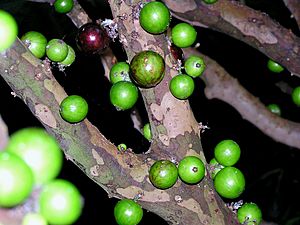Plinia peruviana facts for kids
Plinia peruviana is a special kind of plant. People in Brazil often call it jabuticaba cabinho. This means "small stemmed jabuticaba." It belongs to the Myrtaceae family, which includes plants like eucalyptus. This plant grows naturally only in central South America. This means it is "endemic" to that area.
Quick facts for kids Plinia peruviana |
|
|---|---|
 |
|
| Scientific classification | |
| Genus: |
Plinia
|
| Species: |
peruviana
|
| Synonyms | |
|
|
Contents
What is Plinia peruviana?
The Plinia peruviana is a tree. It can grow quite tall, from about 4 to 14 meters high. That's like a building with several floors! You usually find these trees in certain types of forests. They often grow where different trees, like araucaria pines, are mixed together. They also like flat areas near rivers, called alluvial plains. You can also spot them in open forest areas.
The Fruit of Plinia peruviana
This tree produces tasty fruits that you can eat. The fruits are small, about 18 to 25 millimeters across. That's roughly the size of a marble. When they are ripe, they turn a dark purple color. What makes these fruits special is how they grow. Unlike other jabuticaba fruits, these ones hang from the tree on long stems. This makes them look a lot like cherries!
How People Use Plinia peruviana
The fruits of Plinia peruviana are very useful. You can eat them fresh right off the tree. They are also great for making other delicious things.
Food and Drinks
People often turn these fruits into jelly. They also make refreshing juice from them. If you're older, you might find them in wine or liqueur.
Other Interesting Uses
Scientists have studied the fruit of Plinia peruviana. They found it could be used in other cool ways. For example, it might work as a natural dye to color things. It could also be used as a flavouring to make food taste better.
The fruit is also known to be an antioxidant. Antioxidants are good for your body. They help protect your cells from damage.
Scientists also looked at the peel of the fruit. They found that extracts from the peel can help fight against fungal infections. It can also protect plants from something called copper toxicity. This means it helps keep plants healthy when there's too much copper around.
See also
 In Spanish: Plinia peruviana para niños
In Spanish: Plinia peruviana para niños

